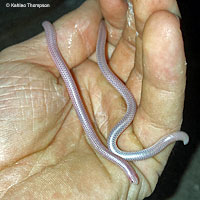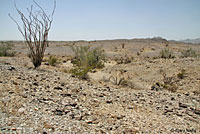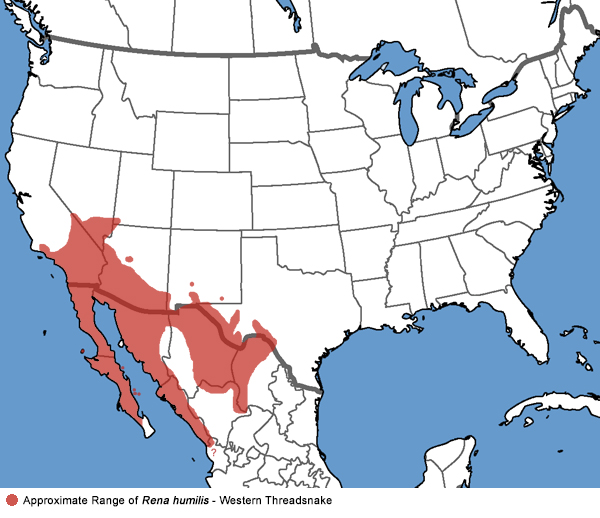|
 |
| Juvenile, Imperial County |
 |
 |
 |
| Adult, Imperial County |
Adult, San Diego County Desert |
 |
 |
 |
| |
Adult, San Diego County Desert |
|
 |
 |
 |
| Juvenile, Imperial County |
Adult, Imperial County |
 |
 |
 |
| Adult, San Diego County desert. © Gary Nafis. Specimen courtesy of Tim Burkhardt |
Adult Imperial County
© Kahleo Thompson
|
| |
|
| Habitat |
 |
 |
 |
| Habitat, Imperial County |
Habitat, San Diego County |
Habitat, Imperial County desert |
| |
 |
|
| |
Habitat, Imperial County |
|
| |
|
|
| Short Videos |
 |
 |
|
| A large Desert Threadsnake found crossing a road at night was captured then released, wriggling rapidly across the rocky desert ground until it finds a hiding place. This shows how fast a threadsnake is capable of moving when frightened, but not necessarily its typical behavior. |
This large Desert Threadsnake was observed apparently searching fors then attacking an ant colony that was moving or relocating their eggs in San Diego County. At the end it looks like the snake may have disappeared down into the ant nest. © Jeff Nordland |
|
|
|
|
|
Description |
Not Dangerous - This snake does not have venom that can cause death or serious illness or injury in most humans.
Commonly described as "harmless" or "not poisonous" to indicate that its bite is not dangerous, but "not venomous" is more accurate. (A poisonous snake can hurt you if you eat it. A venomous snake can hurt you if it bites you.)
|
| Size |
Adults 7 - 16 inches long (18-41 cm). Hatchlings are around 4 - 5 inches long (10 - 12.7 cm).
|
| Appearance |
A very thin snake with a blunt head and tail.
The tail is tipped with a small spine.
Eyes are nonfunctional dark spots visible under translucent plates.
The scales are shiny and cycloid.
Belly plates are not enlarged.
The lower jaw is countersunk.
This snake can be mistaken for a large worm. |
| Color and Pattern |
Coloring is brown, purple, or pink.
|
| Similar Snakes in California |
There are two subspecies of Western Threadsnake in California. There is also a very similar non-native blindsnake that has been introduced into Southern California and is gradually increasing its range in the state - the Brahminy Blindsnake.
Go to this page to see more information about comparing the Western Threadsnake with the Brahminy Blindsnake, and suggestions about what to do if you think you have found a Brahminy Blindsnake in California.
|
| LIfe History and Behavior |
Activity |
Nocturnal. Occasionally found crawling exposed on surface at night. Sometimes seen crawling on paved roads at night. Hides in cracks and under surface debris in daytime. Sometimes found under rocks, boards, or other surface debris where the soil is slightly moist.
|
| Defense |
| When threatened, this snake often writhes around, forming a tight coil while releasing pungent fluids from the cloaca. These fluids serve to repel defensive attacks by the ants and termites on which it feeds. May also play dead. |
| Diet and Feeding |
Eats ants and termites and their larvae and pupae, and occasionally other small insects.
When hunting for food, burrows under roots, rocks, and into ants nests.
Slender body allows them to forage in their ant and termite prey's burrow systems.
|
| Owls and Threadsnakes |
Screech Owls have been observed bringing live threadsnakes (blindsnakes) to their nests. The snakes sometimes escape being eaten by the nestlings and burrow into the nest materials where they feed on insect larvae that would otherwise parasitize the owl nestlings. According to a study by researchers at Baylor University, it is possible that the owls bring the snakes intentionally to keep the nest clean of parasites, because most of the prey they bring to their nestlings has been killed, but the blindsnakes are brought live. They also found that screech-owl chicks are healthier and grow faster in nests that have threadsnakes.
(F. R. Gehlback and R. S. Baldridge. Live blind snakes (Leptotyphlops dulcis) in eastern screech owl (Otus asio) nests: a novel commensalism. Oecologia (Berlin) (1987): 560-563.) |
| Reproduction |
Mates in the spring.
Females are oviparous - laying eggs sometime between July - August, and tending to them.
They may use communal nests.
|
| Habitat |
Inhabits areas where the soil is suitable for burrowing: brushy mountain slopes, deserts, rocky hillsides, washes near streams.
|
| Geographical Range |
This subspecies, Rena humilis cahuilae - Desert Threadsnake, is found in southeastern California east of the peninsular ranges into southwest Arizona, south into Sonora and Baja California.
Finding information about the ranges of the subspecies of Rena humilis is difficult, because they are not recognized by many herpetologists. Some field guides show no subspecies. Some show the range of R. h. humilis extending as far north of Needles, while others show it ranging to just north of the Riverside County border at the Colorado River, as I have decided to show on my map, although I am not certain that it is accurate.There is almost no information about the other subspecies found in Mexico so I have not tried to show them on my map.
The species Rena humilis - Western Threadsnake, is found from Southern California east through southern Arizona and New Mexico, into southwestern Texas, and south into Mexico and Baja California, Mexico.
|

(Several subspecies are sometimes recognized, but I don't know their exact ranges outside of California.)
|
| Notes on Taxonomy |
In 2009, Adalsteinsson, Branch, Trape, Vitt & Hedges (Molecular Phylogeny, Classification, and Biogeograpy of Snakes of the Family Leptotyphlopidae (Reptilia, Squamata). Zootaxa. 2240: pp. 1 - 50) placed this species in the genus Rena, making it Rena humilis humilis.
---------------------------------------------------------------------------------------------------------------------------------------------------------------------
Some herpetologists do not recognize subspecies of Rena humilis.
Those who do recognize four subspecies of Rena humilis in the United States, and five in Mexico.
---------------------------------------------------------------------------------------------------------------------------------------------------------------------
Hansen and Shedd 2025 do not recognize Rena humilis subspecies: "...we regard the minor scalation differences as reflecting clinal variation and not diagnostic, and therefore we consider the species monotypic (see Flores-Villela et al. 2022.)
---------------------------------------------------------------------------------------------------------------------------------------------------------------------
"North American” is added to the English name to differentiate Rena from other Threadsnake genera. Taxonomy follows Flores-Villela et al. (2022, Revista Mexicana de Biodiversidad 93: e933933), who reviewed geographical variation in morphology and modified the taxonomic results of previous studies: R. dissecta is re-synonymized with R. dulcis, and R. segrega is elevated to species. No subspecies are recognized."
(Nicholson, K. E. (ed.). 2025 SSAR Scientific and Standard English Names List)
---------------------------------------------------------------------------------------------------------------------------------------------------------------------
Alternate and Previous Names (Synonyms)
Rena humilis cahuilae - Desert Threadsnake
Leptotyphlps humilis - Western Blind Snake (Stebbins 1966, 1985, 2003, Stebbins & Mcginnis 2012)
Leptotyphlps humilis cahuilae - Western Worm Snake (Stebbins 1954)
Leptotyphlops humilis - Worm Snake (Ophisaurus ventralis; Glauconia humilis; Stenostoma humile; Siagonodon humilis. California Rena, California Blind Snake; Glass Snake; Sheep-nosed Snake) (Grinnell and Camp 1917)
Leptotyphlops humilis cahuilae - Western worm snake (Klauber 1928)
Worm snake (Stejneger 1891)
Humble sheep snake (Cronise 1868)
Blind snake
Brown blind snake
California worm snake
Cedros island worm snake
|
| Conservation Issues (Conservation Status) |
| None |
|
|
Taxonomy |
| Family |
Leptotyphlopidae |
Threadsnakes (Blind Snakes) |
Stejneger, 1892 |
| Genus |
Rena |
North American Threadsnakes |
Baird & Girard, 1853 |
| Species |
humilis |
Western Threadsnake |
Baird & Girard, 1853 |
Subspecies
|
cahuilae |
Desert Threadsnake |
Klauber, 1931 |
|
Original Description |
Leptotyphlops - Stejneger, 1892
Leptotyphlops humilis - (Baird & Girard, 1853) - Cat. N. Amer. Rept., Pt. 1, p. 143
Leptotyphlops humilis cahuilae - Klauber, 1931 - Trans. San Diego Soc. Nat. Hist., Vol. 6, No. 23, p. 339
from Original Description Citations for the Reptiles and Amphibians of North America © Ellin Beltz
|
|
Meaning of the Scientific Name |
Rena = either Latin = Reborn, or Greek = Peace
humilis - Latin = small or ground dwelling -- no specific reason in original description.
cahuilae - of Lake Cahuila -- near the type locality in California
from Scientific and Common Names of the Reptiles and Amphibians of North America - Explained © Ellin Beltz
|
|
Related or Similar California Snakes |
R. h. humilis - Southwestern Threadsnake
|
|
More Information and References |
California Department of Fish and Wildlife
Hansen, Robert W. and Shedd, Jackson D. California Amphibians and Reptiles. (Princeton Field Guides.) Princeton University Press, 2025.
Stebbins, Robert C., and McGinnis, Samuel M. Field Guide to Amphibians and Reptiles of California: Revised Edition (California Natural History Guides) University of California Press, 2012.
Stebbins, Robert C. California Amphibians and Reptiles. The University of California Press, 1972.
Flaxington, William C. Amphibians and Reptiles of California: Field Observations, Distribution, and Natural History. Fieldnotes Press, Anaheim, California, 2021.
Nicholson, K. E. (ed.). 2025. Scientific and Standard English Names of Amphibians and Reptiles of North America North of Mexico, with Comments Regarding Confidence in Our Understanding. Ninth Edition. Society for the Study of Amphibians and Reptiles. [SSAR] 87pp.
Samuel M. McGinnis and Robert C. Stebbins. Peterson Field Guide to Western Reptiles & Amphibians. 4th Edition. Houghton Mifflin Harcourt Publishing Company, 2018.
Stebbins, Robert C. A Field Guide to Western Reptiles and Amphibians. 3rd Edition. Houghton Mifflin Company, 2003.
Behler, John L., and F. Wayne King. The Audubon Society Field Guide to North American Reptiles and Amphibians. Alfred A. Knopf, 1992.
Robert Powell, Roger Conant, and Joseph T. Collins. Peterson Field Guide to Reptiles and Amphibians of Eastern and Central North America. Fourth Edition. Houghton Mifflin Harcourt, 2016.
Powell, Robert., Joseph T. Collins, and Errol D. Hooper Jr. A Key to Amphibians and Reptiles of the Continental United States and Canada. The University Press of Kansas, 1998.
Bartlett, R. D. & Patricia P. Bartlett. Guide and Reference to the Snakes of Western North America (North of Mexico) and Hawaii. University Press of Florida, 2009.
Bartlett, R. D. & Alan Tennant. Snakes of North America - Western Region. Gulf Publishing Co., 2000.
Brown, Philip R. A Field Guide to Snakes of California. Gulf Publishing Co., 1997.
Ernst, Carl H., Evelyn M. Ernst, & Robert M. Corker. Snakes of the United States and Canada. Smithsonian Institution Press, 2003.
Taylor, Emily. California Snakes and How to Find Them. Heyday, Berkeley, California. 2024.
Wright, Albert Hazen & Anna Allen Wright. Handbook of Snakes of the United States and Canada. Cornell University Press, 1957.
Joseph Grinnell and Charles Lewis Camp. A Distributional List of the Amphibians and Reptiles of California. University of California Publications in Zoology Vol. 17, No. 10, pp. 127-208. July 11, 1917.
|
|
|
The following conservation status listings for this animal are taken from the April 2024 State of California Special Animals List and the April 2024 Federally Listed Endangered and Threatened Animals of California list (unless indicated otherwise below.) Both lists are produced by multiple agencies every year, and sometimes more than once per year, so the conservation status listing information found below might not be from the most recent lists. To make sure you are seeing the most recent listings, go to this California Department of Fish and Wildlife web page where you can search for and download both lists:
https://www.wildlife.ca.gov/Data/CNDDB/Plants-and-Animals.
A detailed explanation of the meaning of the status listing symbols can be found at the beginning of the two lists. For quick reference, I have included them on my Special Status Information page.
If no status is listed here, the animal is not included on either list. This most likely indicates that there are no serious conservation concerns for the animal. To find out more about an animal's status you can also go to the NatureServe and IUCN websites to check their rankings.
Check the current California Department of Fish and Wildlife sport fishing regulations to find out if this animal can be legally pursued and handled or collected with possession of a current fishing license. You can also look at the summary of the sport fishing regulations as they apply only to reptiles and amphibians that has been made for this website.
This snake is not included on the Special Animals List, which indicates that there are no significant conservation concerns for it in California.
|
| Organization |
Status Listing |
Notes |
| NatureServe Global Ranking |
|
|
| NatureServe State Ranking |
|
|
| U.S. Endangered Species Act (ESA) |
None |
|
| California Endangered Species Act (CESA) |
None |
|
| California Department of Fish and Wildlife |
None |
|
| Bureau of Land Management |
None |
|
| USDA Forest Service |
None |
|
| IUCN |
|
|
|
|






















